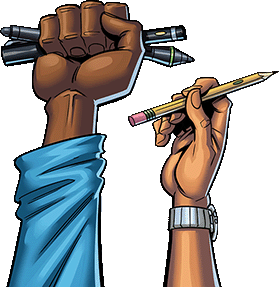Design Tips for Self-Publishing Your Independent Comic Book
October 30, 2020
Comic books have been a strong presence in popular culture, especially American pop culture, since 1938, when Action News #1 hit the stands with Superman gracing its cover.
Now in the 21st century, the options for artists and authors are endless. With print-on-demand technology, you can create a comic book or graphic novel without a publishing company.
With a little know-how, a keen sense of social media, and a great idea, you can design, print, and sell your book all on your own. Before you okay your manuscript to go to the presses, however, consider these design tips.
Choosing the Correct Size for Your Comic Book
The size you choose for your comic pages will depend on page layout, theme, and economic considerations. When comic books first erupted onto the pop culture scene, there was only one standard size. Like the themes and boundaries evolving over the decades, so too has the commonly used measures of paper.
A comic book’s regular size is 6.625” x 10.25,” but these days, there are no predetermined common sizes for comics. Graphic novels also don’t have one standard size, but many are printed 6” x 9” or 5.5” x 8.5”.
When you’re deciding what size paper to use for your artistic endeavor, think about your own comic collection. Using an uncommon size may make your book stand out from the crowd, or it might prove unwieldy and hard to display or store.
Selecting the Right Paper
There are two angles from which to consider your paper choices – style and weight. The paper’s style is how it looks to the reader, whether it’s glossy or matte, for example. The weight of your paper is how thick it is.
To help research which paper will be best for you, look at an array of comics and graphic novels. Observe how the pages look in each, and which you prefer. If you would like a shiny effect, you will have the option of gloss-coated paper, which will be reflective.
Also note how the paper feels between your fingers, in other words, its weight. If you choose sheets of paper that are too thin, your comic book will only last a couple of reads before it starts to rip. Thicker pages are more expensive, but they also ensure darker colors won’t bleed through the page and become visible on the other side.
Comic publishers use offset or text stock of 80 lbs., although standard copy paper for book publishing is usually 55 to 65 lbs. If you would like, you can opt for a thicker cover with glossy or matte coating and thinner, uncoated pages inside, like many comic book artists do.
Consider Your Binding
The other component of your comic book design is the type of binding you would like. You can choose saddle-stitched, customary for comic books, or perfect bound, often used for long stories and graphic novels.
Saddle-stitched bindings are created with large paper sheets, with two pages on the front and back, folded, and stapled in the middle. If you’re opting for saddle-stitched bindings, you cannot use a heavy weight of paper as it would be difficult or impossible to staple.
When you want to saddle-stitch a long work or one that has an unusually heavy paper weight, it may not work as well as you would like. Instead, you should look for a perfect bind, which creates a flat area on the binding and can accommodate more pages or thick paper. These come in soft or hardcover.
Additional Tips
Along with crucial design tactics and a clear vision of your comic book’s look and feel, consider its audience, theme, and purpose.
- Audience – It’s always useful to keep your audience in view as you write your script, block out your layout, and consider color and design schemes. For example, if you’re writing for a young audience, you may not have to include as much text or should opt for a larger font.
- Theme – The mood or feeling of your narrative will undoubtedly influence the choices you make. A detective story set in a gritty urban landscape would look superb in black-and-white, and you could probably opt for non-glossy pages to heighten the shadows.
If you’ve written a story full of pizzaz, joy, and bubbly characters, think about a palette of fresh pastels to continue the text’s themes.
- Purpose – Determine your object when it comes to self-publishing your comic book. Are you trying to build a readership? Make money? Propagate the world with as many books as possible? These aims will affect what design decisions you make.
If you’re looking to sell or give away as many comic books as possible, you may want to opt for more budget-friendly methods such as uncoated pages inside.

The Bottom Line
The creative process is complicated and requires consistency, forethought, and dedication, but you’re still making something extraordinary that didn’t exist in the world before. With some simple guidelines and thorough research, you will be able to design a comic book of which to be proud.
Comix Well Spring offers guidance and knowledge at every step of the creative journey, from idea inception to the moment you hold a physical copy of your comic in your hands.


